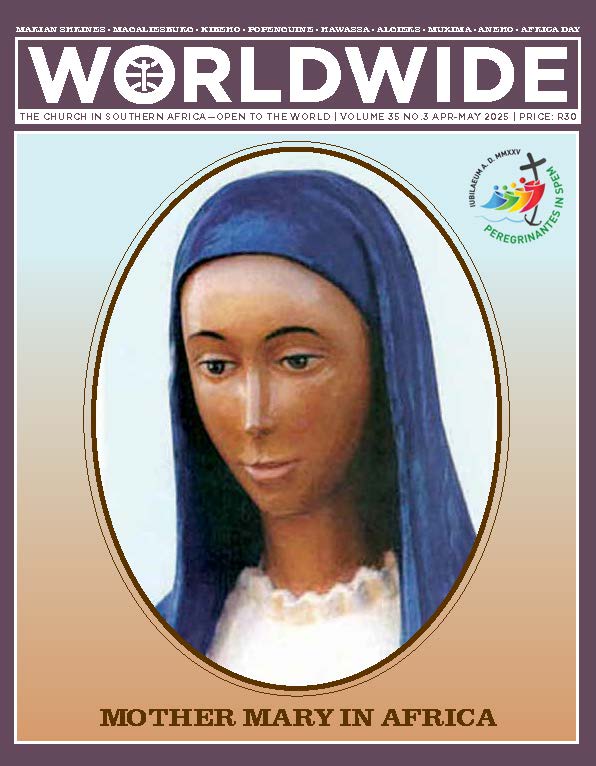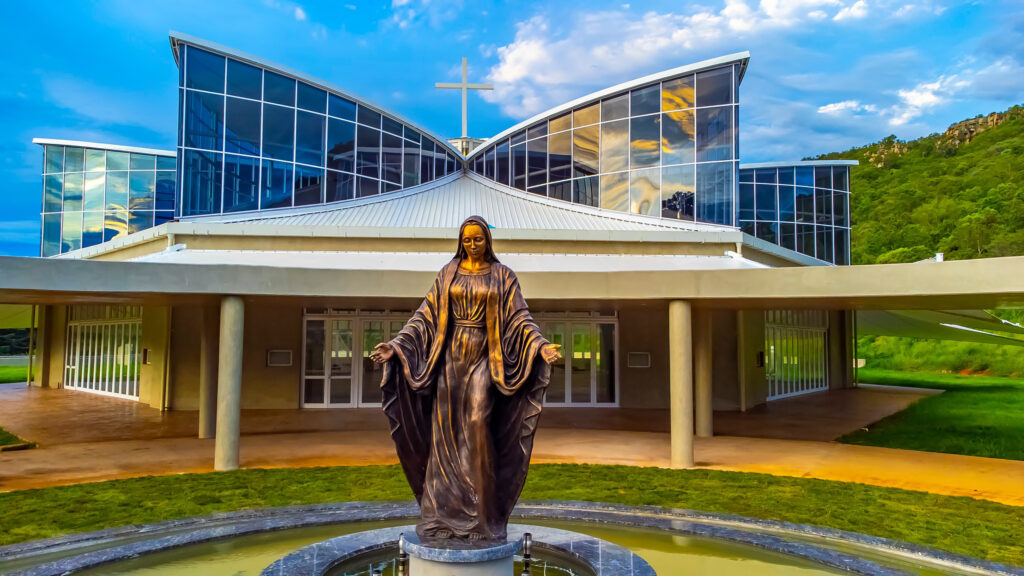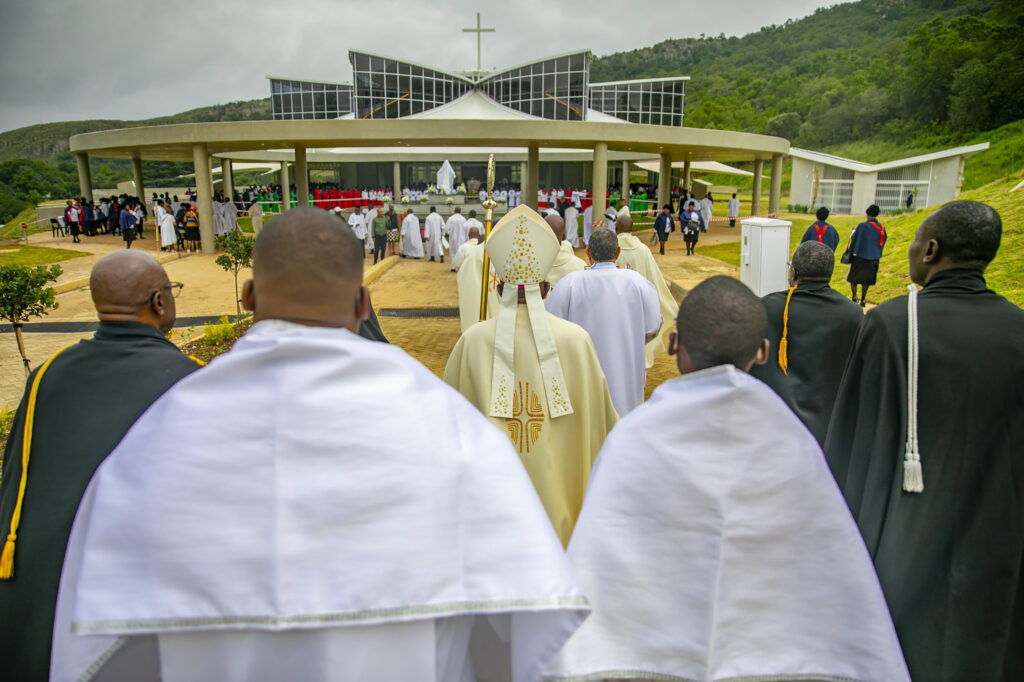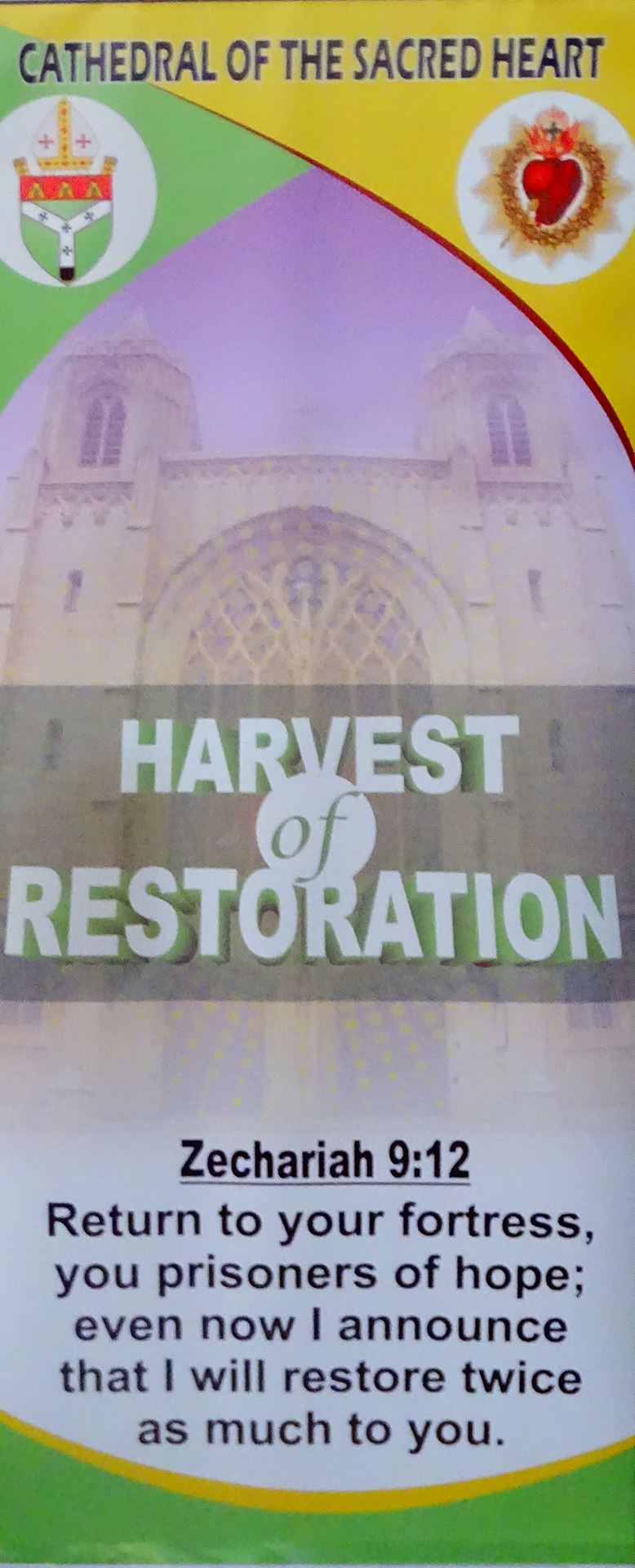
MOTHER MARY IN AFRICA
Head of the Statue of Mother Mary at Kibeho, Rwanda, carved by Marek Kowalski and based on the models of Jean Pierre Sibomana and Faustin Kayitana. In the statue, Mother Mary holds the Seven Sorrows Chaplet, a Marian devotion reintroduced to the Catholic community by Our Lady of Kibeho.
Kibeho is the only Marian apparition on African soil, officially recognized by the Church. Mother Mary’s requests for prayers preluded the 1994 Genocide.
FOCUS • MAGALIESBURG-SOUTH AFRICA

MARY, MOTHER OF MERCY SHRINE: A HOME OF PRAYER
Situated in the serene landscape of Magaliesburg, and a short drive from the Cradle of Humankind— a World Heritage Site—the Shrine of Mary, Mother of Mercy, was officially inaugurated on 27 April 2024 by Archbishop Emeritus Buti Joseph Tlhagale OMI. This was a project, carried out with passion, and officially made known during the extraordinary Jubilee Year of Mercy.
BY KATI DIJANE | CATHOLIC JOURNALIST
IMAGINE STEPPING into a place with a tangible atmosphere saturated with reverence, serenity, and warmth. That is the essence of any Catholic shrine. In the Catholic tradition, a shrine is more than just a physical, grand building; it is a sacred space dedicated to honouring the divine, often associated with significant events, apparitions or miracles. These sanctuaries serve as focal points for pilgrims seeking spiritual solace, miracles and a deeper connection to God and even to the Virgin Mary.
These are some of the sentiments shared by Father Nkosinathi Nkabinde from the Archdiocese of Johannesburg and the rector of Mary, Mother of Mercy Shrine, nestled in Magaliesburg, not far from the economic hub of South Africa.
Beginnings
This project slowly became a reality through the dedication and unwavering support of countless individuals, including Fr Nkabinde, whose journey with the shrine began long before its physical manifestation.

“I became part and parcel of this project from the beginning when I was a parish priest at Our Lady of Africa in Mohlakeng,” he recalls. His deep-rooted devotion to Mother Mary and his prior experience with the Marian Shrine at Tsheseng in his Free State diocese made him an early and enthusiastic supporter of the Archbishop’s vision. “So, when the Archbishop shared this dream, I was among the priests who really took it up and supported it.”
His commitment to supporting the years-long project began by actively engaging his parish in fundraising efforts, starting with the sale of merchandise, including T-shirts and blankets.
What is a shrine in the Catholic tradition?
The Vatican’s Pontifical Council for the Pastoral Care of Migrants and Itinerant People defines a shrine as a place of memory, a reminder of God’s powerful activity in history, which is the origin of the People of the Covenant and the faith of each believer. It continues to explain that, “In the Biblical tradition, the shrine is not merely the work of human hands, filled with cosmological or anthropological symbolism, but a witness to God’s initiative in revealing himself to human persons and making his covenant of salvation with them. The deepest meaning of every shrine is to serve as a reminder in faith of the salvific work of the Lord (Fumio: 4).”
Archbishop Tlhagale mentioned countless times that he wanted to build our Blessed Mother a shrine, which would be a home to Catholics in Johannesburg and beyond.
A shrine in the Catholic context is a holy place marked by its connection to a particular event in the life of Christ, the Virgin Mary, or the saints. The term “shrine” originates from the Latin word scrinium, meaning a container or receptacle for holy relics. Over time, it has come to mean a dedicated site for veneration, pilgrimage and prayer. Shrines vary in form, from grand basilicas to modest chapels built in tranquil landscapes, yet they all serve as sanctuaries of faith and devotion.

Therefore, it is not surprising that Archbishop Tlhagale mentioned countless times that he wanted to build our Blessed Mother a shrine, which would be a home to Catholics in Johannesburg and beyond.
Why are shrines built?
Shrines are built for several profound reasons, including honouring the divine. They serve as tangible expressions of devotion, venerating figures like the Virgin Mary or saints who hold special significance in the Catholic faith. Fr Nkabinde dispels the notion that shrines need to be built in places where apparitions have taken place, as the absence of these in Magaliesburg has raised eyebrows among some.
In his 2017 pastoral letter regarding the shrine, Archbishop Tlhagale wrote that although traditional shrines are generally associated with luminous apparitions such as sightings of a lady shimmering in white, ecstatic encounters, shepherd visionaries, foot-prints, or bloodstains left by the apparitions, and child seers, “here in Magaliesburg, there have been no such happenings. Devotions to Our Lady need not depend on such happenings.” He also mentioned the presence of local shrines in South Africa, such as the one in Ngome, KwaZulu-Natal, which the Vatican has not yet approved, though it was declared locally as a place of prayer in 1992.

Fr Nkabinde also emphasized the importance of ‘Africanising’ the way we worship in line with the Church’s teachings. In the context of Magaliesburg, this intercession is enriched by the inclusion of African symbolism and the relics of the Ugandan martyrs. “The Archbishop has always tried to create a singular African presence in Johannesburg,” he states. “As Africans, we have our own intercessors, including the Ugandan martyrs, who died for their faith. This is why we welcomed their relics in June 2024 at the shrine during the celebration of their feast. Their unwavering faith reminds us that we, Africans, as far as our faith is concerned, are still not free. We’re still growing and many people are persecuted in many ways.”
Shrines also facilitate pilgrimage, providing a place for the faithful to journey towards reflection and prayer. They are also sanctuaries of peace, where individuals can seek comfort, reconciliation and spiritual healing. This is partly the reason for the selection of Magaliesburg as the shrine’s location. With an over 60km drive from the hustle and bustle of Johannesburg’s CBD, the area seemed like a divine inspiration, as suggested by Charles Uloko CSsR from Nigeria at the early phases of the project. Fr Nkabinde describes the shrine as “nature’s paradise,” a place that is quiet and natural, with an atmosphere conducive to prayer.”
A mother’s house, her children’s home
The Archbishop’s leadership style, characterised by collaborative evangelisation, played a crucial role in bringing the shrine to fruition. “The Archbishop will talk to you and say, you know, I wish to have this. And he will leave it that way,” Fr Nkabinde explains. This approach fostered a sense of ownership among those involved, leading to the formation of a dedicated team of “co-founders”, including fundraisers, who worked tirelessly to realize the dream.
The shrine’s name, Mary, Mother of Mercy, is a tribute to the Year of Mercy celebrated by Pope Francis from 8 December 2015 to 20 November 2016. It serves as “a lasting memorial” and a reminder of God’s abundant mercy, channeled through Mary, “the carrier of that mercy.”
Fr Nkabinde added that the shrine’s architecture, inspired by the Wayfarers Chapel in California, features a unique seven-shaped design of leaves, symbolising the seven sacraments. The project has made significant progress since its sod turning in February 2017, with the completion of the multi-purpose hall, the stations of the cross and the recent unveiling and enthronement of the bronze statue of the Mother of Mercy.
The bronze statue of Mary, crafted from local materials, and enthroned on 18 January 2025, embodies her role as a nurturing mother
The rector’s vision for the shrine is one of vibrant spiritual activity. “My desire as a rector is to see that shrine booked and busy with people coming for their spiritual nourishment,” he expresses. He envisions it as “a place where I feel God’s presence.”
While the shrine has come a long way, there’s still much to be done, including the completion of the chapel, capable of accommodating approximately 270 people, and the creation of a room showcasing diverse representations of Mary from around the world. The shrine currently hosts retreats, concerts and fiestas, contributing to its self-sustainability.
The bronze statue of Mary, crafted from local materials and enthroned on 18 January 2025, embodies her role as a nurturing mother, “with open arms to welcome us, to embrace us. Her outstretched hands also symbolise her humility as the handmaid of the Lord,” says the rector of the shrine.
Fr Nkabinde’s hopes for the shrine extend beyond its physical completion. He envisions it as a place of unity among Catholics in South Africa. He highlights the contributions of the community, particularly the “poor and struggling” grannies who have played a vital role in the shrine’s development.

